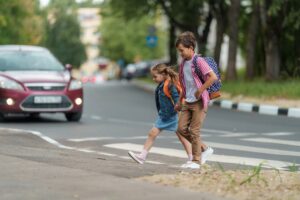San Antonio, nestled in the heart of Texas, exudes a unique charm that captivates residents and visitors alike. With its rich history, diverse culture, and vibrant blend of modernity and tradition, San Antonio attracts pedestrians who come to explore all it has to offer. Unfortunately, the city also ranks last among major metro areas in Texas for pedestrian and cyclist safety, according to the most recent data from the Texas Department of Transportation (TxDOT). Pedestrian accidents can result in serious injuries or even death. Pedestrian accident hot spots, such as busy downtown crosswalks, bustling intersections, and entertainment districts, demand heightened vigilance. Residents and visitors must grasp the importance of adhering to traffic signals, using designated crosswalks, and being aware of their surroundings. You need this knowledge when venturing into popular attractions like the San Antonio River Walk and The Alamo, where an influx of foot traffic intersects with vehicular movement. If you've suffered injuries in a pedestrian accident, contact a San Antonio pedestrian accident lawyer for the support and compensation you deserve. By understanding the specific areas prone to accidents, individuals can confidently explore the city while minimizing risks. Here are some of the places where pedestrian accidents most often occur:
Downtown Crosswalks
In the heart of downtown, the convergence of pedestrians and vehicles is a daily occurrence. The dynamic interplay between foot traffic and cars demands an elevated sense of awareness. Crosswalks, designed to provide a designated path for pedestrians, become pivotal points where the two worlds intersect. Anyone navigating the downtown must understand the risks associated with these crosswalks. Crosswalks often coincide with traffic signals, guiding both pedestrians and drivers. Pedestrians must pay close attention to these signals, waiting for the appropriate moment to cross. Drivers, in turn, should respect these signals, allowing pedestrians to traverse safely. Making eye contact with drivers before stepping onto the crosswalk establishes a visual connection, ensuring that they are aware of your presence. This simple yet effective action can significantly reduce the risk of accidents.Pedestrians should remain focused on the task at hand—crossing the street safely. Avoiding phone use or other distractions while navigating crosswalks is a small but impactful measure to enhance personal safety. Understanding and adhering to pedestrian laws is fundamental. This includes waiting for the walk signal, using designated crosswalks, and refraining from jaywalking. Compliance with these laws contributes to a more organized and safer pedestrian environment.Busy Intersections
Bustling intersections, where roads intersect and traffic converges, present challenges for pedestrians in San Antonio. As pedestrians weave through the complexity of these intersections, understanding the potential dangers is crucial for ensuring safety. Intersections are characterized by a high volume of vehicular traffic, making it challenging for pedestrians to navigate through a constant stream of cars. The sheer intensity of traffic flow increases the risk of collisions. With multiple lanes and various turning options, intersections often have complex traffic signals. Pedestrians may find it challenging to decipher the signals and understand the right of way, leading to potential confusion and unsafe crossing decisions. At intersections, drivers may face numerous distractions, from other vehicles to electronic devices. These distractions can divert a driver's attention away from pedestrians, heightening the risk of accidents. Pedestrians may experience limited visibility due to the density of vehicles, obstructing sight lines for both drivers and those on foot. This reduced visibility makes it challenging for pedestrians to gauge the movements of approaching vehicles accurately. Pedestrians might be tempted to take shortcuts, jaywalk, or disregard traffic signals. Non-compliance with traffic rules increases the likelihood of accidents and compromises the overall safety of the intersection.School Zones
School zones are spaces where the safety of children takes precedence. Recognizing and respecting the priority placed on safety in these areas is essential for both pedestrians and drivers. Pedestrians should always use designated crosswalks when crossing streets in or around school zones. These marked paths are strategically placed to ensure the safest crossing points for pedestrians. Parents and guardians should also educate children about traffic safety. Teach them to use crosswalks, look both ways before crossing, and be cautious around moving vehicles. Many school zones have crossing guards to assist pedestrians. Wait for their signal before crossing, and follow their guidance to ensure a safe journey across the street.
Motorists should respect the reduced speed limits posted in school zones during specific times. Reduced speed limits in school zones are not arbitrary; they are implemented to safeguard the lives of children during crucial times of the day.
By slowing down, drivers can react quickly to unexpected events. This provides a safer environment for pedestrians and an additional margin of safety for children who may dart into the road.
Reduced speeds also significantly decrease the severity of impact in the event of a collision. This is particularly important in areas where children are present, as it minimizes the risk of serious injury.
Drivers should also pay close attention to their surroundings in school zones and avoid distractions like phones or adjusting the radio. They should ensure their full focus is on the road and potential pedestrian traffic.
Many school zones have crossing guards to assist pedestrians. Wait for their signal before crossing, and follow their guidance to ensure a safe journey across the street.
Motorists should respect the reduced speed limits posted in school zones during specific times. Reduced speed limits in school zones are not arbitrary; they are implemented to safeguard the lives of children during crucial times of the day.
By slowing down, drivers can react quickly to unexpected events. This provides a safer environment for pedestrians and an additional margin of safety for children who may dart into the road.
Reduced speeds also significantly decrease the severity of impact in the event of a collision. This is particularly important in areas where children are present, as it minimizes the risk of serious injury.
Drivers should also pay close attention to their surroundings in school zones and avoid distractions like phones or adjusting the radio. They should ensure their full focus is on the road and potential pedestrian traffic.
Residential Streets
In the serenity of quieter residential neighborhoods, potential risks to pedestrians may not seem as obvious, but awareness is key to ensuring safety. Quieter streets may lack dedicated sidewalks or pedestrian-friendly features, exposing walkers to the proximity of vehicular traffic. Limited lighting and fewer vehicles can also reduce visibility, increasing the chances of accidents. Pedestrians should walk on the side of the road facing oncoming traffic. This provides a clear view of approaching vehicles, allowing you to react promptly to potential hazards. If possible, wear bright or reflective clothing, especially during low-light hours. Making yourself easily seen by drivers enhances overall safety. Pedestrians play a pivotal role in their own safety. Assume responsibility for your well-being by staying alert and mindful of your surroundings.Entertainment Districts
Entertainment districts in San Antonio are vibrant and dynamic, offering a lively atmosphere filled with restaurants, bars, and cultural attractions. However, amidst the excitement, it's crucial for pedestrians to recognize the potential hazards and navigate these busy areas with caution. Use designated walkways whenever available. These pathways are strategically designed to provide a safe route for pedestrians amidst the lively energy of the entertainment district. Stay on sidewalks to avoid the unpredictability of vehicular traffic. This simple choice significantly reduces the risk of accidents. Resist the temptation to jaywalk. While it might seem like a shortcut, jaywalking increases the likelihood of collisions. Exercise patience and use crosswalks for a safer journey. Be cautious at intersections and be particularly vigilant for turning vehicles. Drivers may be focused on navigating the bustling streets, making it crucial for pedestrians to anticipate their movements. Navigating the lively atmosphere of entertainment districts is an exciting experience, but it demands a balance of enthusiasm and caution. By using designated walkways, staying on sidewalks, and remaining aware of their surroundings, pedestrians can confidently enjoy the vibrant energy of these districts while ensuring their safety amid the buzz.Parking Lots
Parking lots, though seemingly mundane, can pose significant risks for pedestrians. Recognizing the potential dangers and adopting safety measures are crucial for navigating these areas securely. A common scenario in parking lots involves pedestrians being struck by vehicles backing out of parking spaces. Drivers may have limited visibility when reversing, and pedestrians might be unaware of approaching vehicles. Failure to pay attention to reversing cars or walking in blind spots can result in collisions, emphasizing the need for heightened awareness in parking lots. Stick to designated walkways and pedestrian paths in parking lots. These areas provide a clear route for pedestrians away from moving vehicles. Be vigilant for reverse lights on parked cars. Assume that a vehicle may start moving backward at any time, and exercise caution when walking behind or between parked vehicles.Public Transportation Hubs
Public transportation hubs, including bus stops and train stations, are focal points for pedestrian activity. While these areas are designed to accommodate foot traffic, pay attention to the diverse flow of people and vehicles. Exercise caution, especially when getting on or off public transportation, and pay attention to your surroundings. Transportation hubs, bustling with a constant ebb and flow of commuters, present a unique set of challenges for pedestrians. The concentration of foot traffic in these hubs demands heightened awareness and caution, especially when boarding or alighting from public transportation. Pay attention to directional signs, arrows on the ground, or any other indicators that guide pedestrians. Adhering to the established flow helps maintain order and reduces the risk of collisions. When waiting for public transportation, avoid standing too close to the platform edges. Pay attention to the gap between the platform and the vehicle, ensuring a safe distance to prevent accidental falls or collisions. Whether in a bus terminal or train station, be vigilant for oncoming traffic. This includes buses pulling in, trains arriving, or other pedestrians navigating the space. Stay alert to your surroundings to avoid hazards.Be Aware of Pedestrian Accident Hot Spots in San Antonio
Awareness of potential pedestrian accident hot spots in San Antonio is the first step toward ensuring your safety. Whether you're strolling through downtown, crossing busy intersections, or navigating residential streets, staying vigilant and following traffic rules can significantly reduce the risk of accidents. Remember, your safety is paramount, and by being proactive, you contribute to creating a safer environment for everyone on San Antonio's streets. The Texas Department of Transportation (TxDOT) reports that pedestrian traffic fatalities increased 29.6 percent in Texas in the last five years and now account for one in five of all roadway deaths. In its most recent reporting period, there were 5,764 crashes involving pedestrians in Texas, resulting in 829 deaths. Another 1,526 people were seriously injured.Contact Lorenz & Lorenz Accident & Injury Lawyers PLLC

